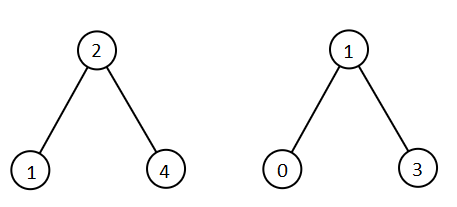[LeetCode] 1305. All Elements in Two Binary Search Trees 两棵二叉搜索树中的所有元素
Given two binary search trees root1 and root2, return a list containing all the integers from both trees sorted in ascending order.
Example 1:

Input: root1 = [2,1,4], root2 = [1,0,3]
Output: [0,1,1,2,3,4]
Example 2:

Input: root1 = [1,null,8], root2 = [8,1]
Output: [1,1,8,8]
Constraints:
- The number of nodes in each tree is in the range
[0, 5000]. -10^5 <= Node.val <= 10^5
这道题给了两棵二叉搜索树,让返回一个包含所有结点值的子数组,并且是有序的。最简单暴力的方法就是分别遍历两棵树,然后把得到的结点值放到一个数组里,然后再对该数组排序,而且也能通过 OJ。用这种方法的话就没有利用到二叉搜索树的性质,用任意一种遍历顺序都可以,参见代码如下:
解法一:
class Solution {
public:
vector<int> getAllElements(TreeNode* root1, TreeNode* root2) {
vector<int> res;
dfs(root1, res);
dfs(root2, res);
sort(res.begin(), res.end());
return res;
}
void dfs(TreeNode* node, vector<int>& res) {
if (!node) return;
dfs(node->left, res);
res.push_back(node->val);
dfs(node->right, res);
}
};
上面的解法并没有利用到二叉搜索树的性质,可能并不是面试官想要看见的解法。二叉搜索树具有左子结点值小于父结点值,小于右子结点的特点,所以用中序遍历得到的结点值是有序的。这里分别对 root1 和 root2 进行中序遍历,分别得到两个有序的数组,这样就可以通过 merge 数组方式来将两个有序数组合并成一个大的有序数组了,是线性的复杂度。下面的代码用的队列而不是数组,并没有太大的区别,参见代码如下:
解法二:
class Solution {
public:
vector<int> getAllElements(TreeNode* root1, TreeNode* root2) {
vector<int> res;
queue<int> q1, q2;
dfs(root1, q1);
dfs(root2, q2);
while (!q1.empty() || !q2.empty()) {
if (q2.empty() || (!q1.empty() && q1.front() <= q2.front())) {
res.push_back(q1.front());
q1.pop();
} else {
res.push_back(q2.front());
q2.pop();
}
}
return res;
}
void dfs(TreeNode* node, queue<int>& q) {
if (!node) return;
dfs(node->left, q);
q.push(node->val);
dfs(node->right, q);
}
};
之前两种解法都是递归的写法,再来看一种迭代的写法,还是用的中序遍历,不过此时是同时中序遍历两棵树,按照大小顺序将结点值加入到结果 res 中,保证了最终的结果是有序的。对于迭代的中序遍历写法最好也是要掌握的,需要用到栈来辅助,由于是同时遍历两棵树,所以这里用两个栈 st1 和 st2。循环到条件是只要 root1,root2,st1 和 st2 有任意一个不为空,中序遍历的顺序是左根右,所以首先要做的把当前结点下方的所有左子结点压入栈中,不停的对 root1 遍历,只要不为空,就将结点压入栈,然后更新为其左子结点。同理对 root2 进行相同的操作,接下俩判断若 st2 为空,说明当前要操作 st1 中的结点,或着若 st1 不为空(此时 st2 也不为空),且 st1 的栈顶结点值小于等于 st2 的栈顶结点值时,同样操作 st1 中的结点。否则操作 st2 中的结点,操作方法都是取出栈顶结点,将其值加入结果 res 中,然后更新为其右子结点即可,参见代码如下:
解法三:
class Solution {
public:
vector<int> getAllElements(TreeNode* root1, TreeNode* root2) {
vector<int> res;
stack<TreeNode*> st1, st2;
while (root1 || root2 || !st1.empty() || !st2.empty()) {
while (root1) {
st1.push(root1);
root1 = root1->left;
}
while (root2) {
st2.push(root2);
root2 = root2->left;
}
if (st2.empty() || (!st1.empty() && st1.top()->val <= st2.top()->val)) {
root1 = st1.top(); st1.pop();
res.push_back(root1->val);
root1 = root1->right;
} else {
root2 = st2.top(); st2.pop();
res.push_back(root2->val);
root2 = root2->right;
}
}
return res;
}
};
Github 同步地址:
https://github.com/grandyang/leetcode/issues/1305
参考资料:
https://leetcode.com/problems/all-elements-in-two-binary-search-trees/











【推荐】国内首个AI IDE,深度理解中文开发场景,立即下载体验Trae
【推荐】编程新体验,更懂你的AI,立即体验豆包MarsCode编程助手
【推荐】抖音旗下AI助手豆包,你的智能百科全书,全免费不限次数
【推荐】轻量又高性能的 SSH 工具 IShell:AI 加持,快人一步
· 阿里最新开源QwQ-32B,效果媲美deepseek-r1满血版,部署成本又又又降低了!
· 开源Multi-agent AI智能体框架aevatar.ai,欢迎大家贡献代码
· Manus重磅发布:全球首款通用AI代理技术深度解析与实战指南
· 被坑几百块钱后,我竟然真的恢复了删除的微信聊天记录!
· AI技术革命,工作效率10个最佳AI工具
2017-05-29 [LeetCode] 568. Maximum Vacation Days 最大化休假日
2015-05-29 [LeetCode] Combination Sum III 组合之和之三